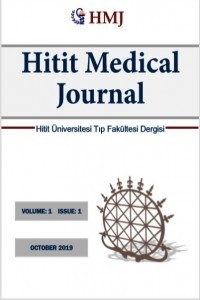COVID -19 hastalarında arka segment optik koherens tomografi bulguları
COVID-19, retina, optik koherens tomografi, maküler kalınlık, retina sinir lifi tabakası
Posterior segment optical coherence tomography findings in patients with COVID-19
COVID-19, retina, optical coherence tomography, macular thickness, retina nerve fiber layer thickness,
___
- 1. Lu R, Zhao X, Li J, et al. Genomic characterisation and epidemiology of 2019 novel coronavirus: implications for virus origins and receptor binding. Lancet. 2020;395(10224):565–74.
- 2. To KF, Lo AWI. Exploring the pathogenesis of severe acute respiratory syndrome (SARS): The tissue distribution of the coronavirus (SARS-CoV) and its putative receptor, angiotensin-converting enzyme 2 (ACE2). J Pathol. 2004;203(3):740–3.
- 3. Li K, Wohlford-Lenane C, Perlman, et al. Middle east respiratory syndrome coronavirus causes multiple organ damage and lethal disease in mice transgenic for human dipeptidyl peptidase 4. J Infect Dis. 2015;213(5):712–22.
- 4. Glass WG, Subbarao K, Murphy B, Murphy PM. Mechanisms of Host Defense following Severe Acute Respiratory Syndrome-Coronavirus (SARS-CoV) Pulmonary Infection of Mice. J Immunol. 2004;173(6):4030–9.
- 5. Wu P, Duan F, Luo C, et al. Characteristics of Ocular Findings of Patients With Coronavirus Disease 2019 (COVID-19) in Hubei Province, China. JAMA Ophthalmol. 2020;2019:4–7.
- 6. Peiris JSM, Guan Y, Yuen KY. Severe acute respiratory syndrome. Nat Med. 2004;10:88–97.
- 7. Marinho PM, Marcos AAA, Romano AC, Nascimento H, Belfort Jr R. Retinal findings in patients with COVID-19. Lancet. 2020;395(10237):1610.
- 8. Gascon P, Briantais A, Bertrand E, et al. Covid-19-Associated Retinopathy: A Case Report. Ocul Immunol Inflamm [Internet]. 2020 Nov 16 [cited 2022 Feb 18];28(8):1293–7. Available from: https://pubmed.ncbi.nlm.nih.gov/33021856/
- 9. Sawalha K, Adeodokun S, Kamoga GR. COVID-19-Induced Acute Bilateral Optic Neuritis. J Investig Med High Impact Case Reports [Internet]. 2020 Nov 25 [cited 2022 Feb 18];8. Available from: https://journals.sagepub.com/doi/10.1177/2324709620976018
- 10. Turkish Health Ministry, Scientific Comity Study, Guidelines for COVID-19 [Internet]. 2020. Available from: https://covid19bilgi.saglik.gov.tr/depo/rehberler/COVID-19_Rehberi.pdf?type=file
- 11. Seah I, Agrawal R. Can the Coronavirus Disease 2019 (COVID-19) Affect the Eyes? A Review of Coronaviruses and Ocular Implications in Humans and Animals. Ocul Immunol Inflamm [Internet]. 2020;28(3):391–5. Available from: https://doi.org/10.1080/09273948.2020.1738501
- 12. Gralinski LE, Baric RS. Molecular pathology of emerging coronavirus infections. J Pathol. 2015;235(2):185–95.
- 13. Wu F, Zhao S, Yu B, et al. A new coronavirus associated with human respiratory disease in China. Nature. 2020;579:265–9.
- 14. Yüzbaşioğlu E. The Latest Pandemic : Covid-19 & Eye. Clin Exp Ocul Trauma Infect. 2020;2(1):3–5.
- 15. Yeo C, Kaushal S, Yeo D. Enteric involvement of coronaviruses: is faecal–oral transmission of SARS-CoV-2 possible? Lancet Gastroenterol Hepatol. 2020;5(4):335–7.
- 16. Li Z, Liu T, Yang N, et al. Neurological manifestations of patients with COVID-19: potential routes of SARS-CoV-2 neuroinvasion from the periphery to the brain. Front Med [Internet]. 2020; Available from: http://www.ncbi.nlm.nih.gov/pubmed/32367431
- 17. Collison FT, Carroll J. Seeking clarity on retinal findings in patients with COVID-19. Lancet [Internet]. 2020 Sep 19 [cited 2022 Feb 18];396(10254):e38. Available from: http://www.thelancet.com/article/S0140673620319176/fulltext
- 18. Brandão-de-Resende C, Diniz-Filho A, Vasconcelos-Santos D V. Seeking clarity on retinal findings in patients with COVID-19. Lancet [Internet]. 2020 Sep 19 [cited 2022 Feb 18];396(10254):e37. Available from: http://www.thelancet.com/article/S0140673620319188/fulltext
- 19. Ouyang P, Zhang X, Peng Y, Jiang B. Seeking clarity on retinal findings in patients with COVID-19. Lancet [Internet]. 2020 Sep 19 [cited 2022 Feb 18];396(10254):e35. Available from: http://www.thelancet.com/article/S0140673620319218/fulltext
- 20. Venkatesh P. Seeking clarity on retinal findings in patients with COVID-19. Lancet [Internet]. 2020 Sep 19 [cited 2022 Feb 18];396(10254):e36. Available from: http://www.thelancet.com/article/S014067362031922X/fulltext
- 21. Vavvas DG, Sarraf D, Sadda SVR, et al. Concerns about the interpretation of OCT and fundus findings in COVID-19 patients in recent Lancet publication. Eye (Lond) [Internet]. 2020 Dec 1 [cited 2022 Feb 18];34(12):2153–4. Available from: https://pubmed.ncbi.nlm.nih.gov/32647303/
- 22. Gündogan M, Kiliç S, Göktas S, et al. Severe COVID-19 and Retina: Are There Any Retinal Manifestations? Klin Monbl Augenheilkd [Internet]. 2021 [cited 2022 Feb 18]; Available from: https://pubmed.ncbi.nlm.nih.gov/34528229/
- 23. Pereira LA, Soares LCM, Nascimento PA, et al. Retinal findings in hospitalised patients with severe COVID-19. Br J Ophthalmol [Internet]. 2022 Jan 1 [cited 2022 Feb 18];106(1):102–5. Available from: https://pubmed.ncbi.nlm.nih.gov/33067361/
- 24. Ding Y, He L, Zhang Q, et al. Organ distribution of severe acute respiratory syndrome (SARS) associated coronavirus (SARS-CoV) in SARS patients: Implications for pathogenesis virus transmission pathways. J Pathol. 2004;203(2):622–30.
- 25. Gu J, Gong E, Zhang B, et al. Multiple organ infection and the pathogenesis of SARS. J Exp Med. 2005;202(3):415–24.
- 26. Xu J, Zhong S, Liu J, et al. Detection of Severe Acute Respiratory Syndrome Coronavirus in the Brain: Potential Role of the Chemokine Mig in Pathogenesis. Clin Infect Dis. 2005;41(8):1089–96.
- 27. Li YC, Bai WZ, Hashikawa T. The neuroinvasive potential of SARS-CoV2 may play a role in the respiratory failure of COVID-19 patients. J Med Virol. 2020;92(6):552–5.
- 28. Moriguchi T, Harii N, Goto J, et al. A first case of meningitis/encephalitis associated with SARS-Coronavirus-2. Int J Infect Dis [Internet]. 2020;94(March):55–8. Available from: https://doi.org/10.1016/j.ijid.2020.03.062
- 29. Shindler KS, Kenyon LC, Dutt M, Hingley ST, Sarma J Das. Experimental Optic Neuritis Induced by a Demyelinating Strain of Mouse Hepatitis Virus. J Virol. 2008;82(17):8882–6.
- 30. Chin MS, Hooper LC, Hooks JJ, Detrick B. Identification of α-fodrin as an autoantigen in experimental coronavirus retinopathy (ECOR). J Neuroimmunol [Internet]. 2014;272(1–2):42–50. Available from: http://dx.doi.org/10.1016/j.jneuroim.2014.05.002
- 31. Hooper LC, Chin MS, Detrick B, Hooks JJ. Retinal degeneration in experimental coronavirus retinopathy (ECOR) is associated with increased TNF-α, soluble TNFR2 and altered TNF-α signaling. J Neuroimmunol. 2005;166(1–2):65–74.
- Yayın Aralığı: Yılda 3 Sayı
- Başlangıç: 2019
- Yayıncı: Hitit Üniversitesi
Vajinismusta başağrısı, anksiyete ve depresyon
Safiye Gül KENAR, Müjdegül KARACA, Gülnur ÖZAKŞİT, Hatice YÜKSEL, Hesna BEKTAŞ
COVID -19 hastalarında arka segment optik koherens tomografi bulguları
Alev KOÇKAR, Hayati YILMAZ, Betül İlkay SEZGİN, Erdal YÜZBAŞIOĞLU
Mortaliteyle Sonuçlanan Geç Başlangıçlı Warfarin Kaynaklı Cilt Nekrozu Olgusu
Pınar KIRICI, Seval Müzeyyen ECİN, Nihal MAVRAL, Sevil ÇİÇEK, Ebru CELİK
Halil İbrahim ÖLÇÜM, Mehmet Emrah KARADERE
Berkhan TOPAKTAŞ, Meryem ÇETİN
Beyza ERDOĞAN AKTÜRK, Ayşe ERDOĞAN KAYA, Seda TÜRKİLİ
Eda OZDEN TOKALIOGLU, Abdurrahman Alp TOKALIOGLU, Ömer Lütfi TAPISIZ
Kübra FIRTINA TOPCU, Mürşit HASBEK, Seyit Ali BUYUKTUNA, Başak TEK
